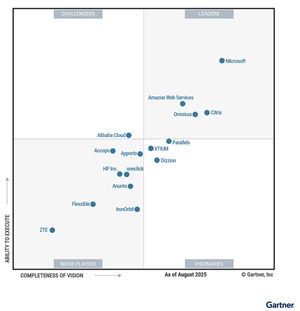News
Gartner: DaaS Expands Beyond Remote Work in 2025
Desktop as a Service (DaaS) is now deployed in most organizations, though typically for a minority of employees, according to Gartner's newly published 2025 Magic Quadrant for DaaS. While secure remote work remains the primary use case, deployments are increasingly aimed at addressing cost, operational and sustainability needs.
The report's strategic planning assumptions project that by 2027, virtual desktops will be cost-effective for 95% of workers, compared to 40% in 2019, and will serve as the primary workspace for 20% of workers, up from 10% in 2019.
 [Click on image for larger view.] 2025 Magic Quadrant for Desktop as a Service (source: Gartner).
[Click on image for larger view.] 2025 Magic Quadrant for Desktop as a Service (source: Gartner).
Market Definition
Gartner defines DaaS as the provision of virtual desktops by public cloud or other service providers. DaaS delivers desktop or application end-user experiences from virtual machines accessed using a remote display protocol. Offerings include a fully managed control plane that brokers user connections and provides a management interface, available either preconfigured as a service or as a platform customers assemble and manage themselves.
Mandatory capabilities for this market include:
- A vendor-managed cloud control plane and remote desktop protocol for secure access.
- Support for a range of endpoints including Windows, macOS and various thin-client OSes.
- Tools for managing resources, users and assignments.
- Orchestration of persistent and nonpersistent compute and storage resources for Windows 10/11 or similar Windows Server experiences.
- Management technology for central image updates, vendor-provided compute and storage, and application publishing.
- Real-time audio/video optimization for unified communications platforms such as Microsoft Teams, Cisco Webex and Zoom.
Common features cited in the report include:
- GPU workload support.
- Hybrid/multicloud deployment options.
- Integration with IT service management tools.
- Digital experience monitoring.
- Support for nontraditional endpoint OSes.
Market Overview
Gartner forecasts DaaS spending to grow from $4.3 billion in 2025 to $6.0 billion by 2029, a 7.9% compound annual growth rate. Net-new desktop virtualization deployments are almost exclusively DaaS, with on-premises VDI either migrating to DaaS or adopting a cloud control plane for all but a few specialized cases.
Cost optimization is becoming a driver for adoption. The report notes that total cost of ownership for DaaS, especially when paired with thin-client endpoints, is now lower than that of a laptop PC for many use cases. Vendors are adding AI-based capabilities for right-sizing configurations and improving efficiency.
Leaders
The 2025 Leaders quadrant features:
- Microsoft – Offers Azure Virtual Desktop, Windows 365 and Microsoft Dev Box, combining self-assembled and vendor-assembled options. Benefits from broad workplace, cloud and AI integration, though Azure Virtual Desktop is seen as more complex to configure than Windows 365.
- AWS – Provides Amazon WorkSpaces and AppStream, with strong geographic coverage, out-of-the-box monitoring and automation, and vertical-specific solutions.
- Citrix – Longstanding desktop virtualization vendor with broad configuration flexibility, regulatory compliance options, and a strategy to deliver an experience "as good or better than a local PC."
- Omnissa – Horizon platform supports on-premises, hybrid and multicloud deployments, with a proprietary protocol optimized for high-latency connections and broad geographic support.
Report Access
While the full Magic Quadrant is typically available to Gartner clients, vendors often provide complimentary licensed-for-distribution versions that can be located via a web search.
About the Author
David Ramel is an editor and writer at Converge 360.